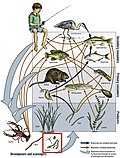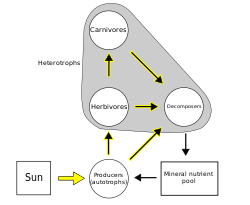Food web
A food web is similar to a food chain but larger. The diagram combines many food chains into energy relationships among organisms. Food webs show how plants and animals are connected in many ways. The arrow points from the organism being eaten to the organism that eats it.
A food web (or food cycle) is a natural interconnection of food chains. The two extreme categories (trophic levels) are:
- the autotrophs, and
- the heterotrophs.
A gradient exists: there are different kinds of feeding relations: herbivory, carnivory, scavenging and parasitism.
Some of the organic matter eaten by heterotrophs, such as sugars, provides energy. Autotrophs and heterotrophs come in all sizes, from microscopic to many tonnes
Food Web Media
A freshwater aquatic food web. The blue arrows show a complete food chain (algae → daphnia → gizzard shad → largemouth bass → great blue heron)
Multitrophic interaction: Euphydryas editha taylori larvae sequester defensive compounds from specific types of plants they consume to protect themselves from bird predators
Paleoecological studies can reconstruct fossil food-webs and trophic levels. Primary producers form the base (red spheres), predators at top (yellow spheres), the lines represent feeding links. Original food-webs (left) are simplified (right) by aggregating groups feeding on common prey into coarser grained trophic species.
– from cyanobacteria to giant redwoods, and from viruses to blue whales.





